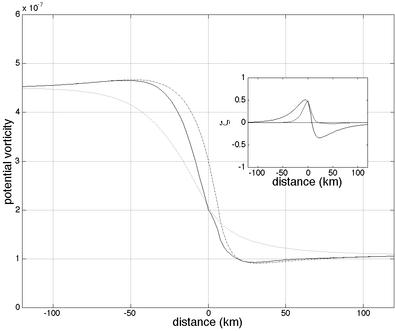|
Concurrent XBTs and historical hydrography are used to construct the
potential vorticity field for the upper layer
(surface to sigmat=27.0).
|
|
The double-exponential velocity pattern is consistent with a
uniformity of potential vorticity between the Gulf Stream and
recirculating gyres to either side, but not across the velocity
maximum where it undergoes a nearly factor 5 change in ~20 km.
|
|
The potential vorticity evinces a slight minimum south
of the velocity maximum that appears to be robust.
|
|
We write Ertel (layer) Potential Vorticity for the upper layer as:
|
| |
|
PV = (f + un-uz[rhon/rhoz])/h,
|
| |
-
where f is the Coriolis parameter,
-
u is downstream velocity,
-
n is the normal direction to the right looking downstream,
-
z is positive upwards,
-
rho is density, and
-
h is upper layer thickness.
|



 Potential Vorticity Structure >>
Eddy Exchange Processes >>
Discussion and Conclusions
Potential Vorticity Structure >>
Eddy Exchange Processes >>
Discussion and Conclusions
